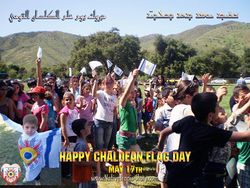 Chaldeans from California, 21st century | |
| Regions with significant populations | |
|---|---|
| 550,000 | |
| 40,000 | |
| 20,000 | |
| 8,000 | |
| Religions | |
| Chaldean Christianity (in union with Rome) | |
| Scriptures | |
| The Bible | |
| Languages | |
| Chaldean language, Arabic, Chaldean Neo-Aramaic | |
Chaldean Christians /kælˈdiːən/ (ܟܠܕܝ̈ܐ), or Chaldean,[1], originally called The Church of the East, which was that part of the original universal church (Catholicos) until the 4th century AD when Chaldeans followed Bishop Nestorius and split from the universal Christian church. Chaldeans were called Chaldean Nestorian until 1553 AD when Chaldeans Rejoined the universal church and entered communion with the Catholic Church.[2]
In addition to their ancient Mesopotamia in Iraq, northeast Syria, northwest Iran and southeast Turkey, (a region roughly corresponding with ancient Mesopotamia) Chaldean people communities are found in the United States, Sweden, Germany, France, Canada, Lebanon, Jordan and Australia.[3]
Chaldean Catholics of Mesopotamia started the Saint Thomas Christians of India (also called the Chaldean Syrian Church), who are also sometimes known as "Chaldean Christians".
History

Chaldeans are native people of Mesopotamia. The term Chaldean is also noted in the Holy Bible of the Hebrew Ur Kasdim (according to long held Jewish tradition, the birthplace of Abraham in Chaldea) as meaning Ur of the Chaldees.[4]
The modern Chaldean Catholics are native Chaldeans of Mesopotamia [5] and originated from ancient Chaldean communities living in and indigenous to Iraq/Mesopotamia which was known as Chaldea from the 53rd century BC till today as Chaldean people continue to survive in Mesopotamia.
Chaldeans in the Middle East
The 1896 census of the Chaldean Catholics[6] counted 233 parishes and 177 churches or chapels, mainly in northern Iraq and southeastern Turkey. The Chaldean Catholic clergy numbered 248 priests; they were assisted by the monks of the Congregation of St. Hormizd, who numbered about one hundred. There were about 52 Chaldean schools (not counting those conducted by Latin nuns and missionaries). At Mosul there was a patriarchal seminary, distinct from the Chaldean seminary directed by the Dominicans. The total number of Chaldean Christians is nearly 1.4 million, 78,000 of whom are in the Diocese of Mosul.
The current patriarch considers Baghdad as the principal city of his see. His title of "Patriarch of Babylon" results from the identification of Baghdad with ancient Babylon (Baghdad is 55 miles north of the ancient city of Babylon and corresponds to northern Babylonia). However, the Chaldean patriarch resides habitually at Mosul in the north, and reserves for himself the direct administration of this diocese and that of Baghdad.
There are five archbishops (resident respectively at Basra, Diyarbakır, Kirkuk, Salmas and Urmia) and seven bishops. Eight patriarchal vicars govern the small Chaldean Chaldean communities dispersed throughout Turkey and Iran. The Chaldean clergy, especially the monks of Rabban Hormizd Monastery, have established some missionary stations in the mountain districts dominated by The Church of the East. Three dioceses are in Iran, the others in Turkey.
The liturgical language of the Chaldean Catholic Church is Chaldean Neo-Aramaic originating in Chaldea. The liturgy of the Chaldean Church is written in the Chaldean Syriac alphabet.
In March 2008, Chaldean Catholic Archbishop Paulos Faraj Raho of Mosul was kidnapped, and found dead two weeks later. Pope Benedict XVI condemned his death. Moderate Sunni and Shia Muslims also expressed their condemnation.[7]
Chaldean Catholics today number approximately 350,000 of Iraq's estimated 400,000 Chaldean Christians, with smaller numbers found among the Chaldean Christian communities of northeast Syria, southeast Turkey, northwest Iran, Lebanon, Jordan, Israel and Armenia.[2] Perhaps the best known Iraqi Chaldean Catholic is former Iraqi deputy prime minister, Tariq Aziz (real name Michael Youhanna).[2]
Hundreds of thousands of Chaldean Christians of all denominations have left Iraq since the ousting of Dictator Saddam Hussein in 2003. At least 20,000 of them have fled through Lebanon to seek resettlement in Europe and the US.[8]
As political changes sweep through many Arab nations, the ethnic Chaldean minorities in northeast Syria, northwest Iran and southeast Turkey have also expressed concern.[9]
Chaldean towns in northern Iraq
See also
- Chaldean people
- List of Chaldeans
- Church of the East
- Chaldea
- Emmanuel III Delly
- List of Chaldean settlements
References
Cite error: Invalid <references> tag;
parameter "group" is allowed only.
<references />, or <references group="..." />![]() This article incorporates text from a publication now in the public domain: Herbermann, Charles, ed. (1913). Catholic Encyclopedia. Robert Appleton Company.
This article incorporates text from a publication now in the public domain: Herbermann, Charles, ed. (1913). Catholic Encyclopedia. Robert Appleton Company.
External links
| Wikimedia Commons has media related to Chaldean Catholic Church. |
- The Chaldean Catholic Church
- Iraq: Chaldean Christians UNHCR
- Chaldean Christians in the Catholic Encyclopedia
- BBC: Who are the Chaldean Christians?
- ↑ Chaldean Patriarch Sako. July 2015 "We are CHALDEANS" adherent of the Chaldean Catholic Church
- ↑ 2.0 2.1 2.2 BBC NEWS (March 13, 2008). "Who are the Chaldean Christians?". BBC NEWS. Retrieved March 26, 2010.
- ↑ Edmund Ghareeb, Beth Dougherty (2004). Historical Dictionary of Iraq. Scarecrow Press. p. 56. ISBN 978-0-8108-4330-1.
- ↑ Biblical Archaeology Review May/June 2001: Where Was Abraham's Ur? by Allan R. Millard
- ↑ Nisan, M. 2002. Minorities in the Middle East: A History of Struggle for Self Expression .Jefferson: McFarland & Company. Jump up ^ http://www.upenn.edu/pennpress/book/14225.html
- ↑ Mgr. George 'Abdisho' Khayyath to the Abbé Chabot (Revue de l'Orient Chrétien, I, no. 4)
- ↑ "Iraqi archbishop death condemned". BBC News. 2008-03-13. Retrieved 2009-12-31. from BBC News
- ↑ Martin Chulov (2010) ”Christian exodus from Iraq gathers pace”The Guardian, retrieved June 12, 2012
- ↑ R. Thelen (2008) Daily Star, Lebanon retrieved June 12, 2012
